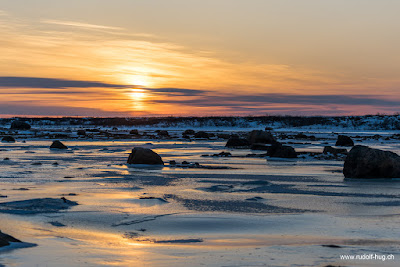It's my fourth trip to the Polar bears on Hudson Bay. This time with guests and so I left my "big lenses" at home and traveled "light". Nevertheless, I was able to photographically capture the fantastic nature experiences. This also thanks to the latest technology from Nikon!
The Seal River Lodge is located about sixty kilometers north of Churchill, just off Hudson Bay. An exceptional cold has built up more ice this year than it usually has around this time of the year. The spectacular sunrise shows how the warmth of the sun fights with the cold of the ice.
Oddly enough, there are no bears around the lodge on our first day at the lodge. Whether they are already on the ice - or waiting for the ice in another place? Hard to say - nature is definitely not a zoo. But on our walking safari we soon find a flock of Willow ptarmigans. These animals, feathery brown/white in summer, have adapted completely to the white environment. They forage on the shoots of the shrubs and are not aware until late - but not too late, that danger approaches in the form of a Polar fox.
Still hungry, the Polar fox roams the area. In the Arctic winter, survival is difficult. Suddenly he pricks his ears as he hears a Lemming, a kind of Mouse, under the blanket of snow. With a giant set he jumps in the air to use gravity to break through the snowpack. But even here he is unlucky - and the Lemming survives.
Even with the Polar hares the Fox has no luck. They have changed their summer dress and wear their winter fur. Only the tips of the ears remain black. So they are well camouflaged. To see further, they can stand on their hind legs and when they run, they can easily reach a speed of over 50 kilometers per hour.
The chances of having good Polar bear encounters are optimal at this time of the year. The ice is still not sustainable enough and there are still too many places with open water. Mother Nature is gracious and spoiles me with dreamlike experiences on the following days. Two females Bears, waiting together for the ice and spending their time roaming and playing. And this in the most beautiful morning light, on the ice and near the lodge.
Polar bears are curious and sometimes they come to the protective fence around the lodge where they can be observed from close range. The fence maintains distance and the guides ensure, that the Bears do not get cocky. This allows to observe the big, impressive animals from a distance as close as about one meter. An very emotional moment.
The Polar fox is still on the lookout for something to eat. For me, a wonderful time comes to an end and I am grateful that I was able to show my guests these unique experiences. The tour was arranged by the Travel agency «Background Tours» of Switzerland and thanks to careful planning, the snowstorm the next day can not stop us from returning home in time.
Many thanks to Mike and Jeanne Reimer and the entire staff of Churchill wild, who make this unique experience possible. Anyone interested in such a tour in 2019 can contact me under: r.hug@mpl.ch .
More pictures can be viewed under the following link:
http://www.rudolf-hug.ch/content/fotogalerie/Travel/Churchill%202017/index.html


















































